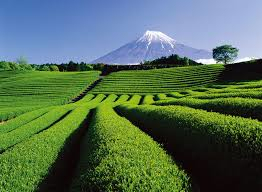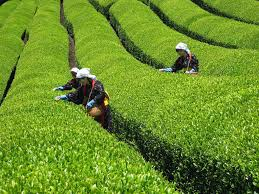You probably realize that tea, in any of its forms, is quite an important element in Japanese society. It can be a daily brew served in restaurants, a friend’s meeting accompanied by a refined beverage or the central aspect of the Zen aesthetic and philosophy expressed in the tea ceremony.
Tea is very much integrated into Japanese culture so no surprise there is a specific term that designates Japanese tea (called “o cha”). The opposite name “ko cha” is used to refer to all non-Japanese teas, including different varieties of oolong and flavoured teas. Japan is the main importer of high-end Darjeelings and best Chinese and Taiwanese exports. It is the only country that consumes its all production, unable to meet the domestic demand. It pushed Japanese to invest in countries like China, Indonesia or Vietnam and grow sencha type teas according to the same methods practiced in Japan. They are sold within the Japanese archipelago and it’s not always mentioned that they are imported.
During my trip to Japan I have learnt about key regions where tea is grown. Main plantations are scattered across flat areas or hillsides in the southern part of the country. Tea can be found in Okinawa in the south to the Hokuriku area in the northwest of Honshu, however most production is concentrated in central Japan. Different regions have their specific tastes and flavors, producing different types of tea. It’s due to the climate which is rather cool, with quite consistent temperatures and rainfalls. The production is nearly exclusively confined to green tea processed by roasting and largely monocultural, limited mostly to Yabukita teas. Harvests take place four times a year, and the first one is by far the most valued. Tea grown in flat regions is characterised by deep green liquor, rich and round taste as well as smooth mouthfeel. Mountainous regions provide bright golden yellow liquor, with balanced taste and strong aroma and slightly astringent.

Key tea growing regions
Shizuoka Prefecture has long been synonymous with green tea production. Famous for Mount Fuji, the region possesses the ideal climate for tea cultivation, giving rise to some of the world’s finest sencha. Shizuoka is the region with climatic conditions that are challenging during much of the year, and this weather is key to the distinctive characteristics of Shizuoka teas. Even when you travel by shinkansen bullet train, you can easily tell that this is a full-fledged tea region as you look out over the beautiful scenery of tea gardens. The tea often gets labeled “Shizuoka tea”, but Shizuoka stretches far from east to west, with altitudes ranging from high to low, so teas from the respective sub-regions have their own distinct tastes and flavours. The yield can be roughly divided into “sato no cha (meaning “tea from the village”) grown in flat areas, and “yama no cha” (“mountain tea”) grown in high altitude regions. What’s more, Shizuoka is not only a tea producing region but, like Kyoto, an area where tea is refined and blended. Tea refiners and wholesalers are concentrated in large numbers, and as tea from other regions is traded and refined in large quantities, Shizuoka also serves as a large distribution centre for Japanese tea. That region not only fabricates sencha leaves of its own plantations, but also those of Honshu and Kyushu. There are two different steps in the method of processing tea, which may take place at different times and locations. The first step is the production of raw tea, and the second is refining leaves and giving them a final form. Shizuoka has about 81 square miles of gardens that are responsible for step 1 – producing on average 45% of all Japanese tea, and step 2 – local factories processing 70% of all tea grown in the country. This region cannot be missed on your map if you plan to visit tea plantations and experience the production process.

Kyoto Prefecture in the Kansai region produces more tencha (the raw material for matcha) than any other prefecture but it is also the originator of both sencha and gyokuro. Not only a region of cultivation, tea from other places is refined and blended in Kyoto, thereby making it one of the main centres for tea distribution in Japan. Its plantations are based near the town of Uji, southwest of Kyoto. Compared to Shizuoka and Kagoshima, the production volumes are rather small and of slightly less significance in terms of scale, delivering just over 3% of the total Japanese output, but many different kinds of tea are produced there, with a wide variety of cultivars grown. In particular, the art of shading tea plants is a highly developed and common practice in Kyoto, and its tencha and gyokuro are praised as teas of the highest quality. Special cultivars for this purpose, such as asahi, samidori, goko and ujihikari, all have their origin in Kyoto. This region cannot be forgotten since it is the birthplace of Japanese culture. Kyoto has a long history going back to when Myoe, a monk at Togano Kozan temple, received tea seeds from Yosai, another monk who brought them back from the Song dynasty in China in 1191. In the 14th century, when tea tasting games were a popular pastime among the warrior class, Togano tea was seens as the true tea, while all the rest were lumped together as “non-teas”.

Kyushu island has equally important prefectures, with Kagoshima being the second-largest tea-growing region, supplying about 22% of the country’s output for all types of tea combined. The other prefectures of Kyushu are the preferred locations for the production of Tamaryokucha tea. Tea is produced on the entire island but some regions like Takachiho in Miyazaki prefecture and Ureshino in Saga prefecture are known for Chinese style pan-fried teas. Their refreshing smoothness and sweet, roasted aroma make them strikingly different from steamed Japanese tea. Kagoshima ranks second in the nation both in terms of cultivated area and production volume, but few know that it used to be a large-scale black tea region. Unfortunately, due to mass production of black tea in countries like India and Sri Lanka, Japanese varieties could not compete on the international market. Luckily, the domestic demand for green tea rose and Kagoshima managed to switch to green tea production. The vast tea gardens stretching as far as the eye can see over a large flat area is a scene unique to Kagoshima. The climate is warmer than other tea growing regions in Japan, so “shincha” (first harvest) is harvested early, and even “yonbancha” (fourth harvest) and “shutoban” (fall and winter harvest) tea are harvested in considerable quantities. Tea grown in this region has strong sunlight so it tends to become bitter and astringent. In order to preserve the natural sweetness of the tea the plants are often shaded. Until a couple of years ago, Kagoshima tea was mainly shipped to Shizuoka for refining, but in recent years its pure tea is being sold in large quantities and regional brands like “Chiran Te” are becoming increasingly known to the Japanese public. Kagoshima is also making great efforts to increase exports, and organic farming is expanding rapidly as a result.

There are also other prefectures and regions where tea is produced, but those three have the most significant importance in Japanese tea manufacturing. Travelling around the country and visiting the local plantations is truly a unique experience and I would highly recommend to anyone who is into tea to go and visit at least one of them.
Happy tea time!
